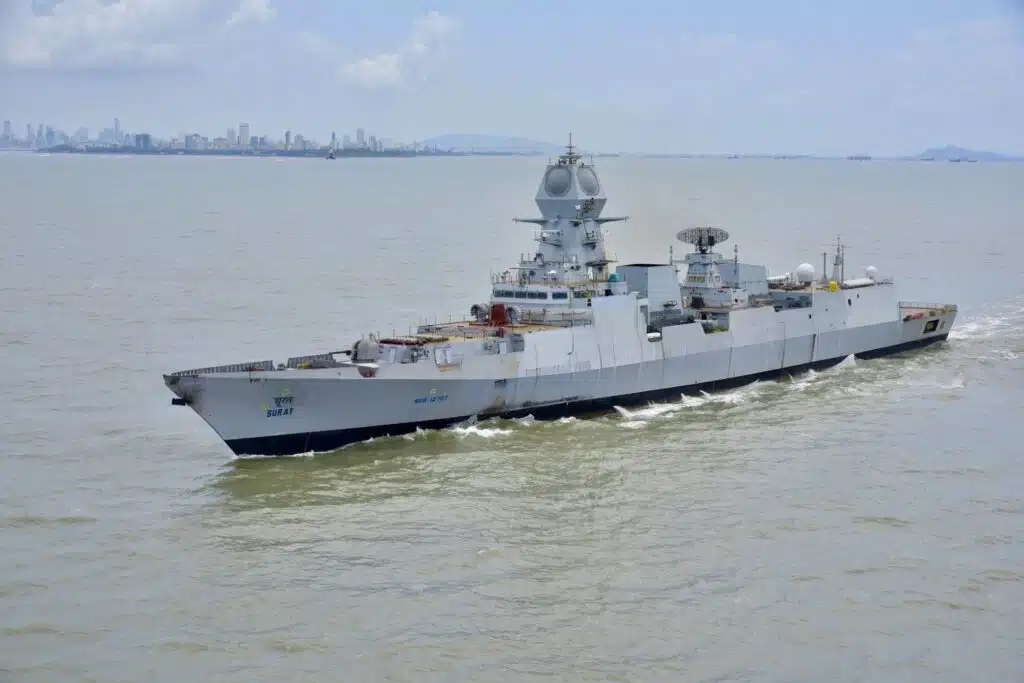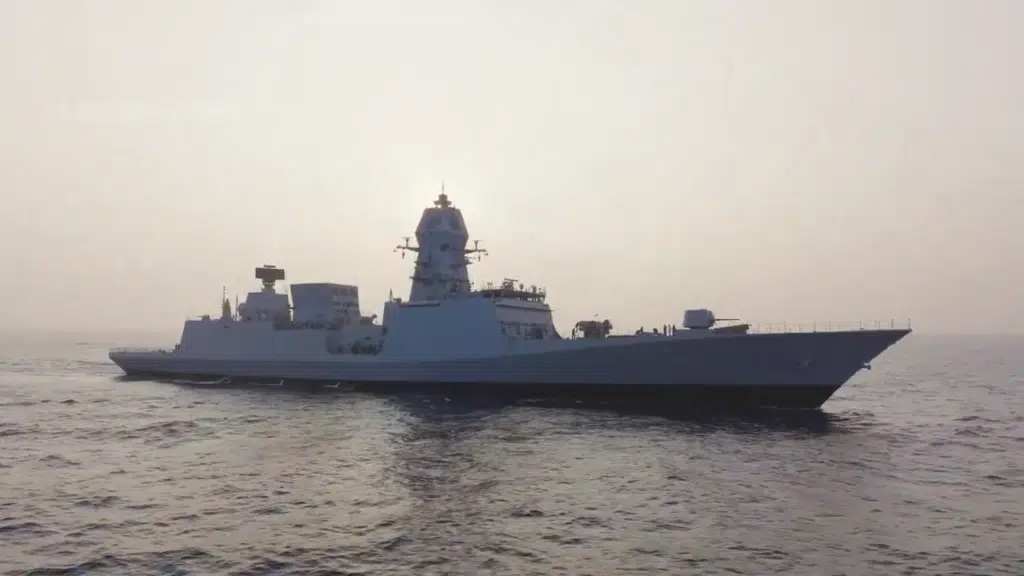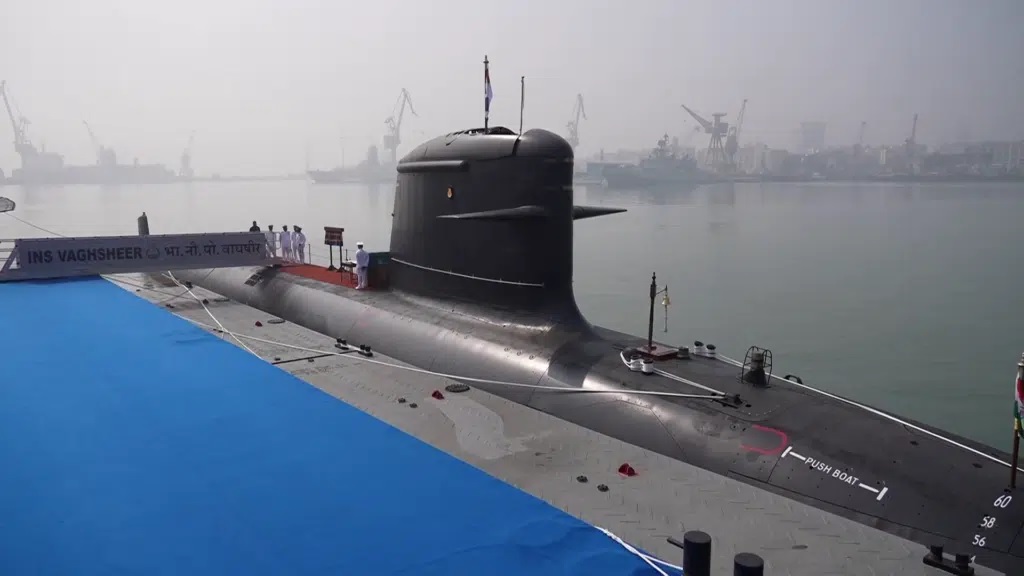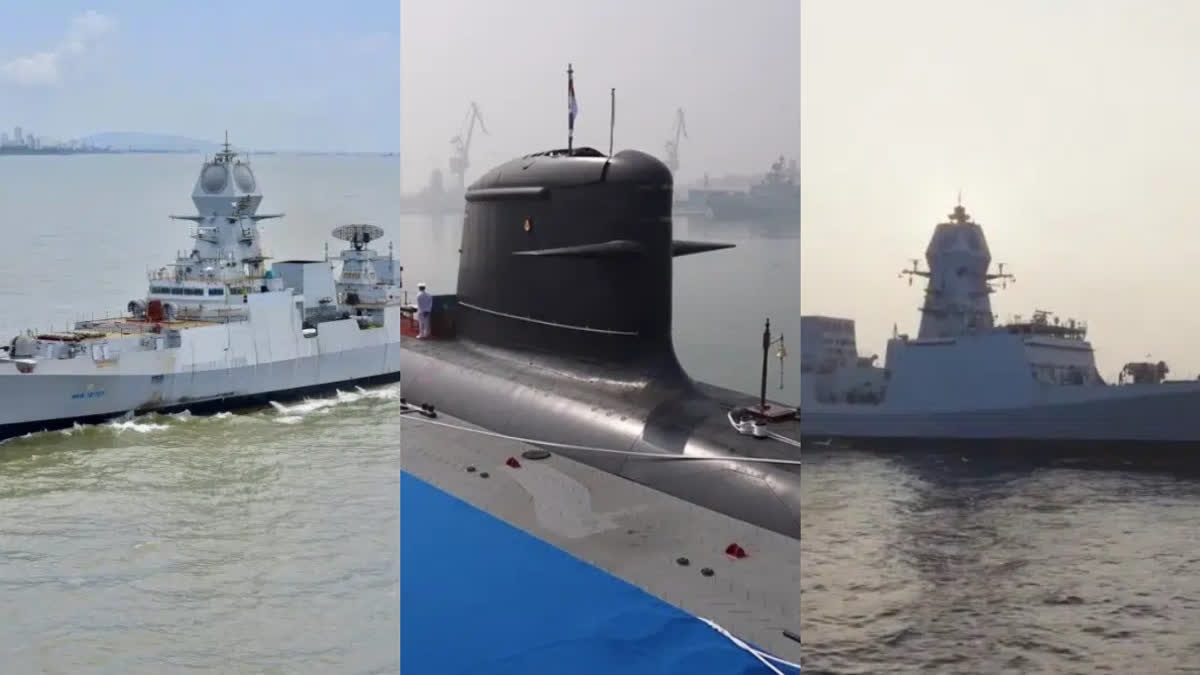The Indian Navy is all set to simultaneously commission three formidable combatant platforms on January 15, 2025. The commissioning ceremony will take place at the Naval Dockyard in Mumbai. The day will see the commissioning of the guided missile stealth destroyer INS Surat, the guided missile stealth frigate INS Nilgiri and the diesel submarine INS Vaghsheer enter the naval service after having completed all their pre-commissioning trials at sea. All three have been built indigenously at the Mazagon Dock Limited (MDL) in Mumbai.
The submarine is based on the French Scorpene design, and the two capital ships are designed by the Indian Navy's Warship Design Bureau (WBD). "It will provide a significant boost to the Indian Navy’s combat potential while underscoring the country’s pre-eminent status in Indigenous shipbuilding," a Navy spokesperson said, describing this as a 'historic milestone'.
Each of the three vessels has a story of technological modernity combined with a strong history and legacy.
Background and Capabilities Of INS Surat
INS Surat (Yard 12707) a warship is the last Project 15 destroyers, an ambitious program that the Indian Navy had flagged off in the early nineties. In the last three decades, ten ships have been built and all have been named after major cities of India. Under the Project 15 scheme ships that were commissioned comprise INS Delhi, Mysore, and Mumbai, while INS Kolkata, Kochi, and Chennai were part of Project 15 A. INS Visakhapatnam, Mormugao, Imphal, and Surat have been built as part of Project 15 A B scheme.
With the delivery of INS Surat culminates the iconic indigenous destroyer building project of the Indian Navy. The beast-like INS Surat brings a displacement of 7,400 tonnes and an overall length of 164 meters to the table. INS Surat is big and almost the size of a cruiser. She is also among the most technologically advanced destroyers in the world. It is equipped with the latest weapons, which include surface-to-air missiles, anti-ship missiles, medium-and-close-range guns, anti-submarine torpedoes, and rockets.
INS Surat is powered by four gas turbines delivering up to a total of 64,000 horsepower. She is capable of speeds in excess of 30 knots (about 60 km per hour) and has an extended reach of over 7,500 kilometres. The ship's flight deck and helicopter hangars can operate two multi-role helicopters, as well as drones, which gives it the much-required flexibility in tactical operations.

The cutting-edge equipment in INS Surat makes her capable of being deployed across the full spectrum of naval operations. It has state-of-the-art sensors, radars, sonars, and electronic warfare systems. INS Surat is also equipped with advanced communication and navigation suites that enable much higher situational awareness and networking-centric operations.
Additionally, INS Surat is touted to be the Indian Navy's first AI-enabled warship which utilised indigenously developed AI solutions. The Integrated Platform Management System (IPMS), also designed indigenously, facilitates control and monitoring machinery from a single point remote location. INS Surat is the most modern ship the Indian Navy has so far.
"With INS Surat's commissioning into the blue waters, the world will see India's ship construction, engineering prowess, and industrial knowledge about destroyers building. It also reinforces the Indian Navy's focus on 'Atmanirbharta' or self-reliance in the defence sector. While the ship is built in India, the weapons and sensor onboard INS Surat are also built in the country," says Commodore (Retd) Srikant Kesnur.
Before being commissioned on January 15, the ship completed its sea trials in six months and was delivered to the Indian Navy in 31 months from launch on May 22 to delivery in December 2024, considered to be the fastest for a ship of this size.
One of the best aspects of INS Surat is that it has dedicated accommodation for women officers and sailors onboard. This move boosts the deployment of women on board frontline warships.
In history, India's journey with warship building began with a small ship, INS Ajay in 1960. The next in line was survey ship Daeshak in 1967 which gained momentum with the Leander (Nilgiri class) warship from the late 60s, followed by the Godavari class in the 80s, which was also the first in-house-designed ship. India's journey into being Indigenous in the defence sector became word-class with Project 15, Delhi class, destroyers. The form, firepower, weapon-sensor miz, seakeeping, and other parameters in the Delhi class were compared with international standards. In the last two decades, the platforms have only become better with modifications and enhancements. All ten of them have been built in Mumbai's Mazagon Docks.
History of INS Surat
Almost all units in the Indian Navy have names that contain certain meanings or historical significance. In INS Surat's case, it comes from the city of Surat which has been an important hub of maritime trade for markets across the oceans. It also has a rich shipbuilding legacy.
Interestingly, Commodore (Retd) Kesnur shares, that the British journey in India began in Surat, when an East India Company ship 'Hector' arrived in Surat in August 1608. "The British obtained permission to trade from Emperor Jahangir, a squadron of four EIC warships arrived off Surat on September 5, 1612, the date, the British regard as the foundation of the Indian Navy."
INS Nilgiri's background and capabilities
The lead ship of the Nilgiri-class stealth frigates, INS Nilgiri is developed as part of the Indian Navy's Project 17A. The advanced warship represents a significant leap. The design incorporates stealth features, cutting-edge weaponry, and sensors, making it a formidable addition to India’s maritime arsenal. It is equipped with a robust propulsion system, INS Nilgiri has the capability to achieve high speeds while maintaining fuel efficiency. Its design minimises radar cross-section, making it harder to detect by enemy forces.

The ship is armed with a variety of surface-to-air and surface-to-surface missiles, a naval gun, and advanced torpedo systems, enabling it to undertake anti-submarine, anti-air, and anti-surface warfare operations. Additionally, it can accommodate and operate helicopters, further enhancing its operational versatility. The frigate is equipped with advanced electronic warfare systems, integrated combat management systems, and state-of-the-art communication systems to ensure superior situational awareness and decision-making capabilities.
INS Vaghsheer's background and capabilities
INS Vaghsheer is the sixth and final submarine of the Kalvari class, constructed under the Indian Navy’s Project-75, the initiative aimed at bolstering underwater combat capabilities. Built in collaboration with the French Naval Group, INS Vaghsheer represents the culmination of efforts to develop advanced diesel-electric attack submarines with cutting-edge technology and stealth features tailored to India’s maritime requirements.
The submarine is designed for stealth and versatility, it has a hydrodynamic hull that minimises acoustic signatures and enhances manoeuvrability. It is equipped with a powerful arsenal of torpedoes, anti-ship missiles, and mines, enabling it to execute a range of combat operations, including anti-surface and anti-submarine warfare. Advanced sensors, including sonar and periscopic systems, provide superior underwater surveillance and situational awareness.

INS Vaghsheer also has state-of-the-art electronic warfare systems, an integrated combat management system, and modern communication equipment to ensure operational effectiveness. Its air-independent propulsion system enhances its endurance and allows it to remain submerged for extended durations, further increasing its stealth and survivability.
As the nation gears up to celebrate 75 years of being a Republic country, India's warship-building programme has been a landmark success. In recent years, India has designed and built several aircraft carriers, nuclear submarines, and many other vessels.
However, when it comes to destroyers, they are the most notable models as they operate at the vanguard of the fleet with inbuilt flexibility in the manner of their deployment. These destroyers can be a part of the Carrier Task Force (CFT) or operate independently or in small groups as Surface Action Groups (SAG) or Search and Attack Units (SAU).



